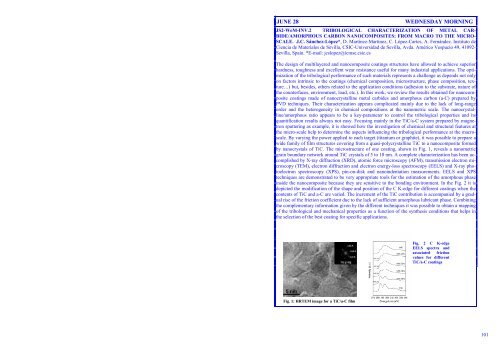Wüest M. 51 Wykes M. 82 Yamaguchi M. 17 Ybarra G. 129 Yubero F ...
Wüest M. 51 Wykes M. 82 Yamaguchi M. 17 Ybarra G. 129 Yubero F ...
Wüest M. 51 Wykes M. 82 Yamaguchi M. 17 Ybarra G. 129 Yubero F ...
Create successful ePaper yourself
Turn your PDF publications into a flip-book with our unique Google optimized e-Paper software.
JUNE 28 WEDNESDAY MORNING<br />
JS2-WeM-INV.2 TRIBOLOGICAL CHARACTERIZATION OF METAL CAR-<br />
BIDE/AMORPHOUS CARBON NANOCOMPOSITES: FROM MACRO TO THE MICRO-<br />
SCALE. J.C. Sánchez-López*, D. Martínez-Martínez, C. López-Cartes, A. Fernández. Instituto de<br />
Ciencia de Materiales de Sevilla, CSIC-Universidad de Sevilla, Avda. Américo Vespucio 49, 41092-<br />
Sevilla, Spain. *E-mail: jcslopez@icmse.csic.es<br />
The design of multilayered and nanocomposite coatings structures have allowed to achieve superior<br />
hardness, toughness and excellent wear resistance useful for many industrial applications. The optimization<br />
of the tribological performance of such materials represents a challenge as depends not only<br />
on factors intrinsic to the coatings (chemical composition, microstructure, phase composition, texture…)<br />
but, besides, others related to the application conditions (adhesion to the substrate, nature of<br />
the counterfaces, environment, load, etc.). In this work, we review the results obtained for nanocomposite<br />
coatings made of nanocrystalline metal carbides and amorphous carbon (a-C) prepared by<br />
PVD techniques. Their characterization appears complicated mainly due to the lack of long-range<br />
order and the heterogeneity in chemical compositions at the nanometric scale. The nanocrystalline/amorphous<br />
ratio appears to be a key-parameter to control the tribological properties and its<br />
quantification results always not easy. Focusing mainly in the TiC/a-C system prepared by magnetron<br />
sputtering as example, it is showed how the investigation of chemical and structural features at<br />
the micro-scale help to determine the aspects influencing the tribological performance at the macroscale.<br />
By varying the power applied to each target (titanium or graphite), it was possible to prepare a<br />
wide family of film structures covering from a quasi-polycrystalline TiC to a nanocomposite formed<br />
by nanocrystals of TiC. The microstructure of one coating, shown in Fig. 1, reveals a nanometric<br />
grain boundary network around TiC crystals of 5 to 10 nm. A complete characterization has been accomplished<br />
by X-ray diffraction (XRD), atomic force microscopy (AFM), transmission electron microscopy<br />
(TEM), electron diffraction and electron energy-loss spectroscopy (EELS) and X-ray photoelectron<br />
spectroscopy (XPS), pin-on-disk and nanoindentation measurements. EELS and XPS<br />
techniques are demonstrated to be very appropriate tools for the estimation of the amorphous phase<br />
inside the nanocomposite because they are sensitive to the bonding environment. In the Fig. 2 it is<br />
depicted the modification of the shape and position of the C K-edge for different coatings when the<br />
contents of TiC and a-C are varied. The increment of the TiC contribution is accompanied by a gradual<br />
rise of the friction coefficient due to the lack of sufficient amorphous lubricant phase. Combining<br />
the complementary information given by the different techniques it was possible to obtain a mapping<br />
of the tribological and mechanical properties as a function of the synthesis conditions that helps in<br />
the selection of the best coating for specific applications.<br />
Fig. 2 C K-edge<br />
EELS spectra and<br />
associated friction<br />
values for different<br />
TiC/a-C coatings<br />
Fig. 1: HRTEM image for a TiC/a-C film<br />
101
















